971
-18.6
20’ Tank
5,914
2,948
-50.2
40’ Tank
53
53
0
TOTAL Containers
1,603,889
1,782,999
11.2
TOTAL TEUs
2,289,073
2,626,237
14.7
E-4
FM 55-80
Having to containerize increasing volumes of goods, customers have sought containers of increased height, length, and width. Containers with the original ANSI/ISO external height of 8 feet are generally being replaced by containers measuring 8 1/2 feet high. Also increasing numbers of containers of 45-, 48-, 53-feet lengths have been brought into domestic service within the United States, Canada, and Mexico.
Because of incompatibility with most ship cells, these longer units (particularly the 45 and 53 footers) have generally been considered a domestic asset. Forty-eight footers, 8 feet wide, are becoming popular on some international routes, with the servicing carriers moving these assets either in specially modified holds or above deck.
Despite this trend of volumetric growth, the majority of the US-owned standard dry cargo container fleet remains 20-and 40-foot units with each type continuing to grow as shown in Table E-3. Currently, the US-owned container fleet is essentially equally divided in number between 20-and 40-foot units. This means that approximately two-thirds of the total standard dry cargo carrying capacity is in 40-foot units. Only the 20-foot ANSI/ISO container will be used for the movement of ammunition (Class V). DOD will no longer procure 40-foot containers. The 20-foot container is the container of choice whenever it meets mission requirements. Commercial industry may use 40-foot containers to move all classes of supply (less Class V) and unit equipment subject to theater reception and onward movement capabilities. The Army force structure must be prepared to handle both 20-and 40-foot ANSI/ISO containers.
While it is necessary for DOD to monitor trends in the quantity of commercial containers, the truly important factor to the defense planning community is the availability of these assets.
Worldwide economic conditions dictate the number and location of containers which are available for DOD use. A key factor in determining availability is the quantity of lessor-owned containers not already under lease to a DOD shipper or ocean carrier (and hence available for lease by DOD). This quantity, expressed as a percentage of all lessor-owned containers, is referred to as the “off-hire rate.” Its value depends largely on the balance of trade, favorable balance of trade will increase the demand for containers for overseas shipment, decreasing the number of off-hire (available) containers within the US.
Off-hire rates can vary considerably by container type. Specialty containers, such as refrigerated units, flatracks, and open containers, often have a higher use rate (lower off-hire rate) than standard dry ANSI/ISO units. In recent years, a specific market niche has been established for the standard 20-foot dry box (serving geographic regions and customers with less intense shipping requirements and lesser developed infrastructures). The off-hire rate for these commercial assets has also generally decreased in recent years.
E-7.
CONTAINER TYPES. A sample of container types are depicted in Figures E-1 through E-7. They include both military and commercial intermodal marine containers, most of which are identical in nature.
E-8.
ANSI/ISO END OPENING COMMERCIAL. The commercial 20-foot end-opening container can be used to transport munitions or general cargo. The door end corner posts are modified with angle iron to enhance blocking and bracing. As there is no permanent restraint system, wooden blocking and bracing is used to restrain munitions.
E-5
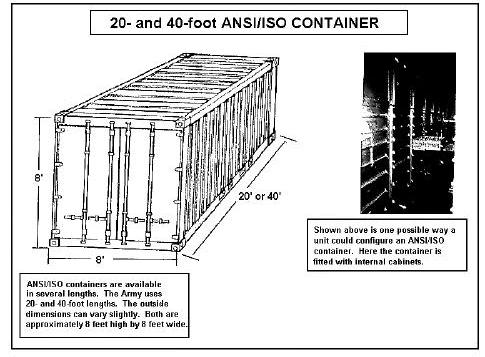
FM 55-80
End-opening dry cargo units are the most common intermodal containers in the inventory (see Figure E-1). They are DOD-owned and available for lease or purchase from commercial sources. End-opening containers come in various lengths. DOD uses only 20- and 40-foot lengths.
DOD owns several container types which fit into this category. All MILVANs and ANSI/ISO end-opening containers can be readily transported by most military and commercial CHE.
Figure E-1
E-9.
MILVAN. The Ammunition Restraint MILVAN is made of steel, with wood flooring and walls and is capable of transporting 39,015 pounds of ammunition. The tare weight of this MILVAN is 5,785 pounds. The total gross weight per MILVAN is 44,800 pounds. It has an internal restraint system of eight slotted steel rails permanently installed on each side wall with 25
adjustable crossbars that can be inserted into the slots.
The General Cargo MILVAN container is made of steel, with hardwood flooring and plywood lined walls and is capable of transporting 40,100 pounds of general cargo. The tare weight of this MILVAN is 4,700 pounds. The total gross weight per MILVAN is 44,800 pounds.
MILVANs are still in use today. In 1989 there was a procurement for 1,160 of the ammunition restraint MILVANs. The older ones are gradually being phased out of the system and replaced by commercial containers. The CADS now uses Army-owned and leased standard 20-foot ANSI/ISO containers.
E-6
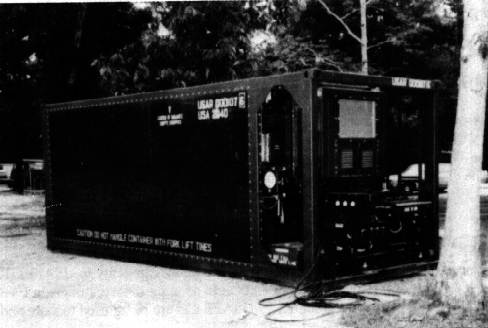
FM 55-80
E-10.
REFRIGERATED CONTAINER. REEFERs are owned by DOD and are available through commercial sources (see Figure E-2). They provide the capability to transport, temporarily store, and distribute temperature-sensitive cargo such as food or blood. Military-owned REEFERs include a refrigeration unit with a 10-kW generator. They can be plugged into an external power source or run off of their own generators. Most ships are equipped with a power source into which the containers can be plugged. Commercial REEFERs are available with their own generator installed in the front wall of the container with the refrigeration unit. Some commercial REEFERs are plugged into a separate generator which fits into an adjoining container cell. REEFERs have the outer dimensions of ANSI/ISO containers and meet all ANSI/ISO requirements for intermodal shipments.
REFRIGERATED CONTAINER (REEFER)
REEFERs come in a variety of different lengths. The Army only uses 20-and 40- foot lengths. A 20-foot REEFER would be 8’ wide by 8 feet high.
The one pictured here has its’ own generator system installed in the nose of the container with the refrigeration unit.
Figure E-2
E-11.
SIDE-OPENING CONTAINER. Twenty-foot side-opening containers are DOD-owned and are available through commercial sources (see Figure E-3, page E-8). They are ANSI/ISO containers with two double doors located on one side. These doors open to allow easy access to the container’s contents. The side-opening container can be lifted and transported by commercial and military conveyances. Military versions have internal tie-down rings which can be used to secure cargo during shipment. The military often uses side-opening containers for transporting munitions.
E-7
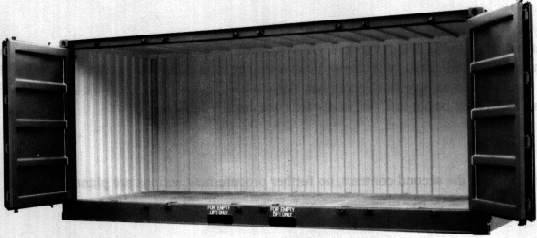
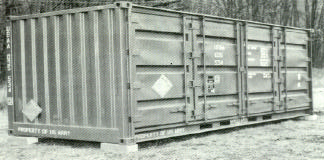
FM 55-80
20-FOOT SIDE-OPENING CONTAINER
Side-opening containers have the same dimensions as the
20-foot end opening ANSI/ISO container. The Air Force is
procuring side-opening containers to use as their standard
munitions container.
Figure E-3
E-12.
OPEN TOP CONTAINER. The open top container is used primarily by commercial industry to transport cargo items that are too large and bulky for standard containers. An open top container can be stuffed from the top, or one end can be opened and it can be stuffed from there. It has ANSI/ISO standard corner fittings at the top and bottom and commercial and military handlers and conveyances can readily lift and transport it. Open top containers require tarpaulins for cover during shipping and storage. Open top containers cannot be used for sensitive items requiring high security and may also have agricultural restrictions.
E-13.
HALF-HEIGHT CONTAINER. Half-height containers are DOD-owned and are available through commercial sources (see Figure E-4). They have the footprint of an ANSI/ISO container with ANSI/ISO standard structural members and corner fittings. They are approximately half the height of a standard end-opening container. They have fixed sides, an open top, and one drop-end opening. Material is accessible by either materials-handling equipment or crane. Tarpaulins accompany the containers for cover during shipping and storage. These containers are useful to ship drummed oils and lubricants.
E-14.
TANK CONTAINER. Commercial tank containers are 8 and 1/2 feet in length and are used to haul liquids, gases, and dry bulk cargo. They can be pressurized or non-pressurized. Prototypes of military PLS compatible ANSI/ISO bulk tank containers are being developed. They can be used for intermodal transport of liquids such as Class III and other liquids and gases. They are a half height design.
These containers will be available through DOD and commercial sources.
E-8

FM 55-80
HALF-HEIGHT CONTAINER
The 20-foot half-height container used by the Army is 20” x 8’ x 4’ 3”.
The Army uses the half-height container primarily to ship ammunition having a high weight to volume ratio such as 155mm projectiles.
Figure E-4
E-15.
EQUIPMENT DEPLOYMENT AND STORAGE SYSTEM. EDSS containers are designed to support unit deployments. This category includes QUADCON, TRICON, and ISU
containers. QUADCONs and TRICONs are primarily for ground and sea transport and Internal Airlift/Helicopter Slingable Container Units are intended for air transport (see Figure E-5, page E-11). All are available in multiple configurations including different doors, internal shelves, and dividers. ISUs are not covered by ANSI/ISO specifications and are not to be used for marine transport in ANSI/ISO 20- and 40-foot configurations. If transported via ship, they would be carried as secondary loads.
a.
QUADCON. QUADCONs are not a common-use asset. They are unit-owned military containers. They were first used as part of the Marine Corps Family of Intermediate Size Containers.
Other Services plan to procure QUADCONs in the near future. These are available to Army units as CTA 50-900 items. The QUADCON is fast becoming the primary EDSS container for surface movements. The QUADCON has ANSI/ISO corner fittings to allow for coupling of the QUADCONs into arrays of up to four units. An array of four QUADCONs has the same external length and width as a 20-foot ANSI/ISO container and is designed to be lifted as a 20-foot unit and/or moved as a 20-foot unit in ocean shipping. The QUADCON is certified to meet all ANSI/ISO standards and CSC approvals.
Each has four-way forklift pockets and lockable double doors on each end that provide full access to the contents. To accommodate smaller items, a small item storage cabinet can be installed or removable inserts may be placed as shelves inside the QUADCON.
b. TRICON. TRICONs are not a common-use asset. They are military containers owned by the Army and the Navy. Like QUADCONs, they are lockable, watertight, and made of steel construction. TRICONs have standard ANSI/ISO corner fittings and 3-way forklift pockets on the side and back. The TRICON has ANSI/ISO corner fittings to allow for coupling into arrays of up E-9
FM 55-80
to three units. An array of three TRICONs has the same external length and width dimensions as a 20-foot ANSI/ISO container and is designed to be lifted as a 20-foot unit in ocean shipping. Two styles of containers have been procured: bulk and configured. Bulk containers do not have drawers, shelves, or rifle racks. Configured containers consist of cabinets with drawers, shelves, rifle racks, or a combination thereof.
c.
ISU-60, -90, and -96. The ISU containers provide weather resistant storage and transport but do not meet ANSI/ISO structural standards. CSC restrictions do not apply to containers specially designed for air transport; however, they are certified for internal or external helicopter transport and for all AMC transport aircraft. If transported aboard a ship, they would be carried as secondary loads. A number of these units have been procured by US Army Airborne and Air Assault units. The ISU-96 is a refrigeration model used primarily to transport medical supplies.
E-16.
FLATRACKS. Flatracks are owned by DOD or are available through commercial sources.
Figure E-6, page E-12, shows both commercial and PLS flatracks . Flatracks enable containerships to transport bulky items such as lumber, steel products, and piping (regular flatrack) and heavy or outsized cargo such as tanks and armored vehicles (heavy-duty flatrack). The flatrack is a structural steel frame, decked over and fitted with tie-down points. One can be used as an individual intermodal container unit or several can be placed side-by-side in a container cell to create a false deck. Some flatracks have corner posts while others have end walls. The corner posts/end walls on most flatracks fold down to facilitate stacking and storage.
The military flatracks come in three sizes: 20-, 35- and 40-foot. Twenty-foot flatracks are PLS compatible. They are used to carry light items that do not fit into a 20-foot container. The 35-footer is used exclusively on FSS. There are three types of heavy duty flatracks (the Titan, the Denardi, and the Phillips). The Titan is equipped with telescoping corner posts adjustable from 102
to 162 inches for various cargo heights. The Denardi and the Phillips have fixed corner posts 156
inches high. Corner posts of all three types fold to facilitate stacking and storage. These flatracks were designed for over-ocean movement and have height restrictions when used in highway/rail transport roles.
E-17.
CONTAINER ROLL OFF PLATFORM. The CROP is a PLS flatrack that fits inside an ANSI/ISO standard 20-foot container. Figure E-7, page E-13, shows a PLS truck pulling a CROP
out of a 20-foot container. The CROP is similar in function to the standard M1077 PLS flatrack except its dimensions: the CROP is 91.5” wide and 230” long so it fits securely inside the ANSI/ISO container. A benefit of using the CROP is that of external protection of ammunition verses tarps. The CROP does not require additional blocking and bracing or materials and only the PLS truck is required to unload in the CSA. Once the CROP is unloaded in the CSA from its ANSI/ISO container, only the CROP flatrack must move forward to ammunition supply/transfer points.
E-10
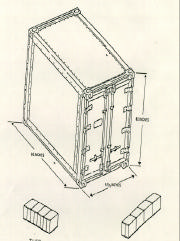
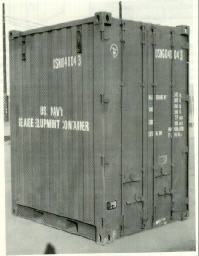

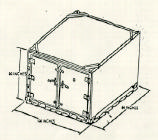
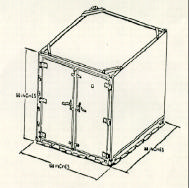
FM 55-80
EQUIPMENT DEPLOYMENT STORAGE SYSTEMS
(EDSS) INCLUDES QUADCONs, TRICONs, ISUs
TRICON
QUADCON
96”
82”
96”
57.38”
This
Not this
96”
Four joined together become a 20-foot
77.5”
ISO container
Three joined together become a 20-foot
ISO container
ISUs are 463L compatible, transportable in C-130 & CH 47
ISU-60
aircraft, external air transport certified, and can be picked up with a forklift. They offer access to cargo from opposite side doors and are weatherproof. They can be fitted with removable bins and drawers as shown below. A reefrigerated version, not 60”
pictured is also available in an ISU-96 size (108”x88”x96”).
They are not ANSI/ISO compatible.
88”
108”
ISU Container
Shelf Cabinets
ISU Doors
ISU-90
90”
Door Bin Kits
Drawer Cabinets
Example of an ISU fitted with
interior shelves to better utilize
108”
88”
and organize the space.
Figure E-5
E-11

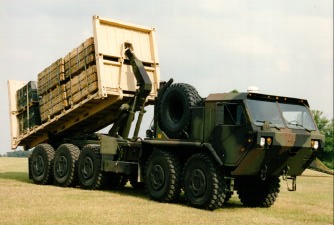

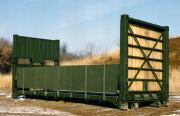
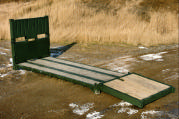
FM 55-80
20-FOOT PLS MILITARY FLATRACKS
General Purpose ISO compatible
M1 Flatrack w/ sideboards
M1 Flatrack
These flatracks are transported by PLS
vehicles. They differ from the CROP. A
CROP fits inside of the container. These
flatracks do not.
M1 Flatrack w/ wall down
(Both walls fold down)
PLS can transport up to
16.5 Tons
& Flatracks on PLS
M1077
M1
FLATRACK
LENGTH 238.5”
WIDTH 96”
HEIGHT 82”
Figure E-6
E-12
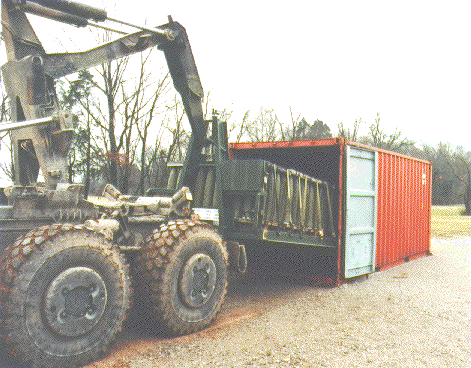
FM 55-80
CONTAINER ROLL-IN/ROLL-OUT PLATFORM (CROP)
CROP
The CROP is a flatrack that fits inside a 20-foot ANSI/ISO Container. Its’ primarily intended to be used to carry Class V. It can be used to carry all classes of supply. The CROP is unstuffed from the container at corps or higher and only the CROP is transported to forward locations.
Figure E-7
E-13
FM 55-80
APPENDIX F
DEPARTMENT OF DEFENSE FORMS
This appendix contains sample copies (reduced to fit on page) of Department of Defense forms that are authorized for local reproduction. You may request these forms through appropriate distribution channels. The forms are as follows:
DD Form 836
Shipping Paper and Emergency Response Information for Hazardous Materials Transported by Government Vehicles
DD Form 1384
Transportation Control and Movement Document
DD Form 1385
Cargo Manifest
DD Form 1386
Ocean Cargo Manifest Recapitulation or Summary
DD Form 1387
Military Shipment Label
DD Form 1387-2
Special Handling Data/Certification
DD Form 1750
Packing List
F-1
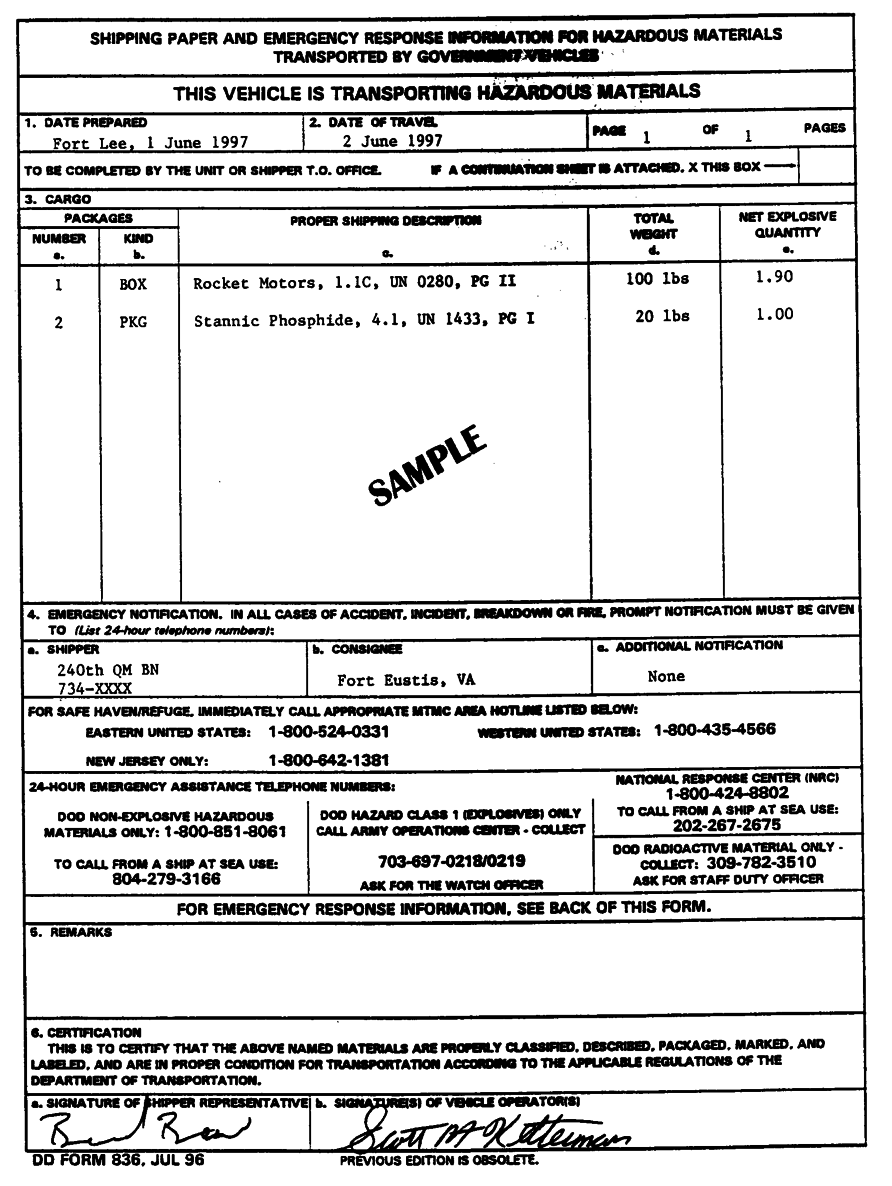
FM 55-80
F-2
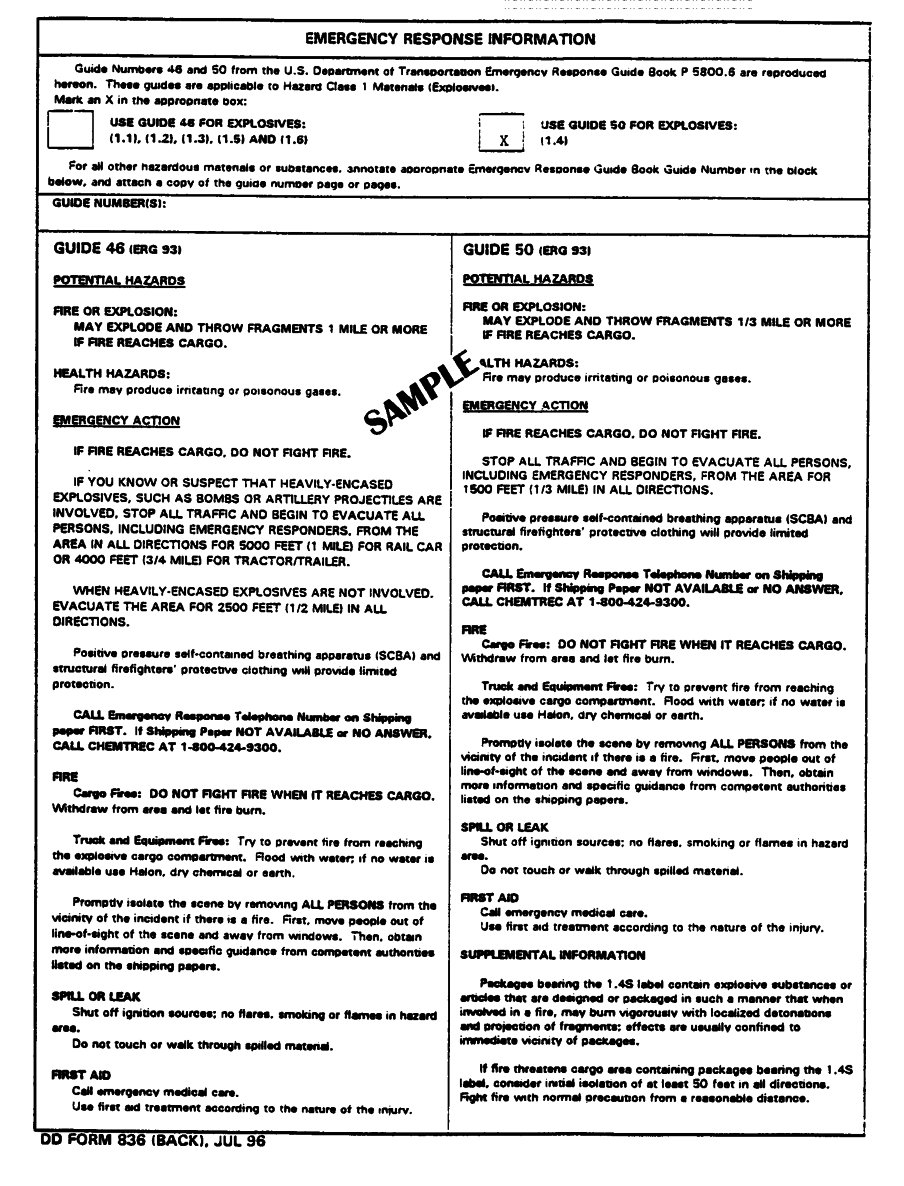
FM 55-80
F-3
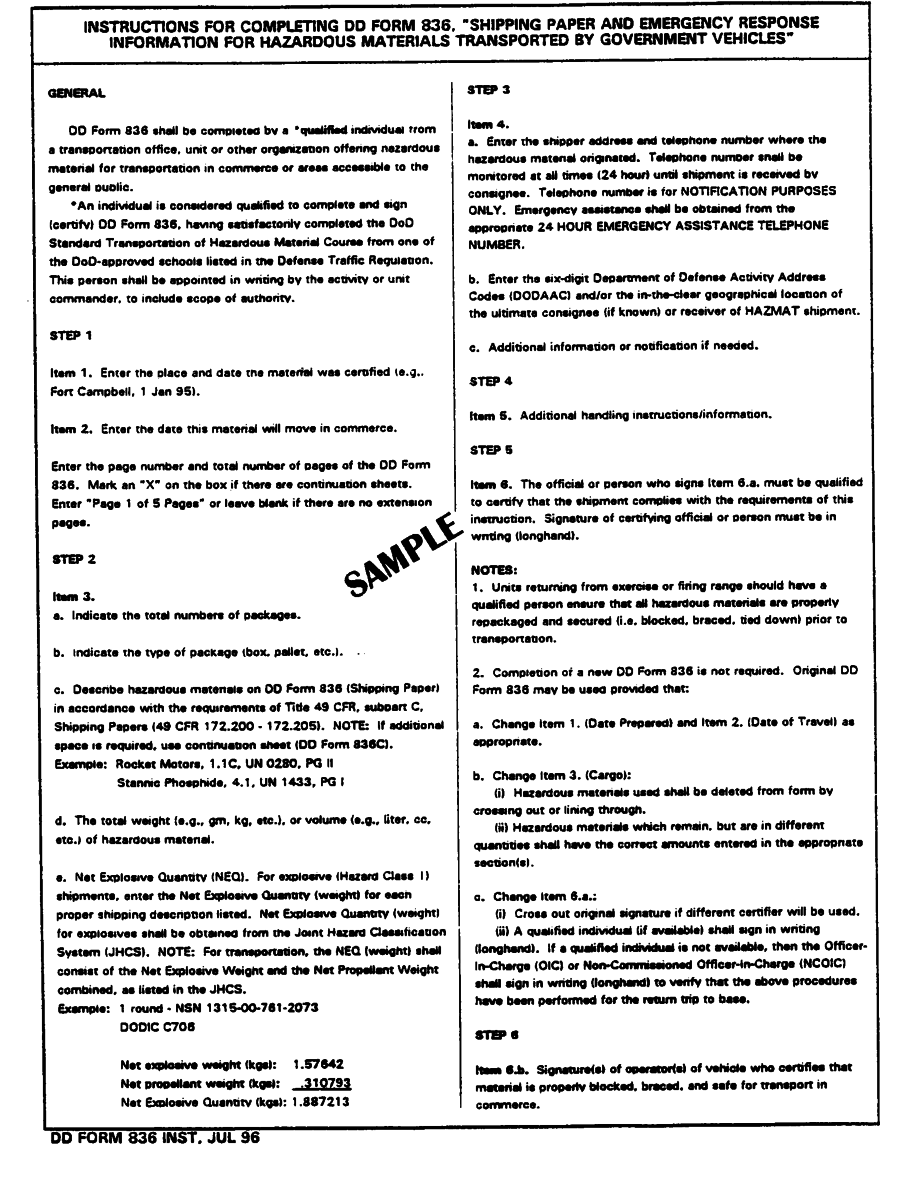
FM 55-80
F-4
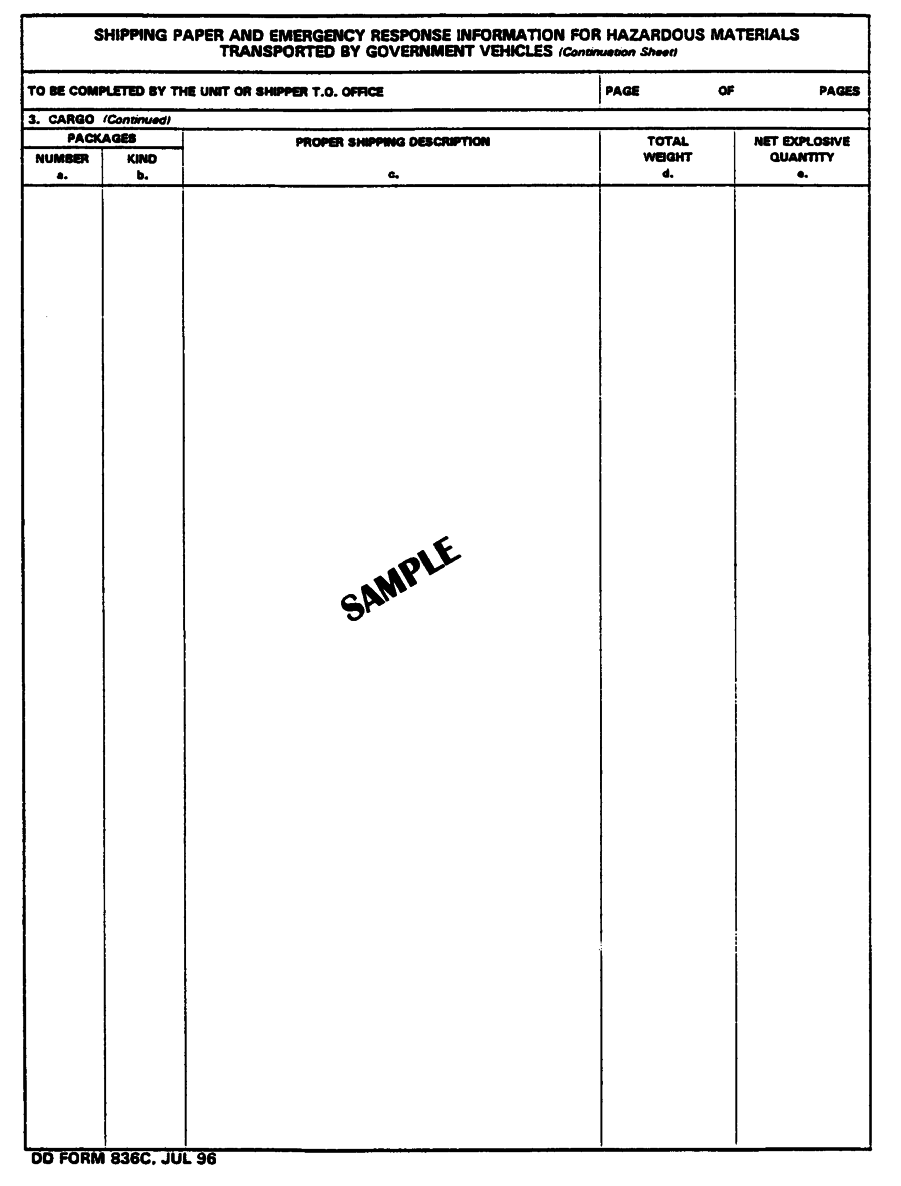
FM 55-80
F-5
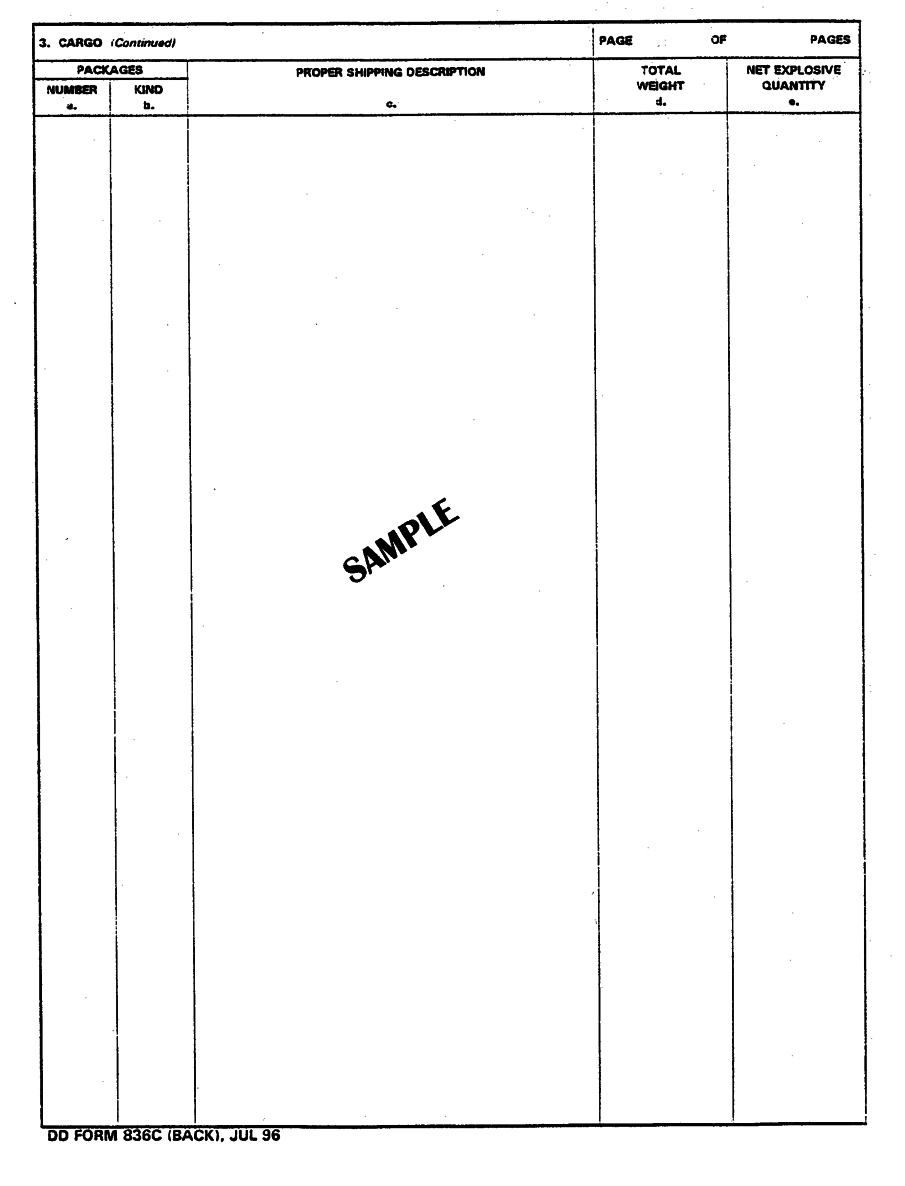
FM 55-80
F-6
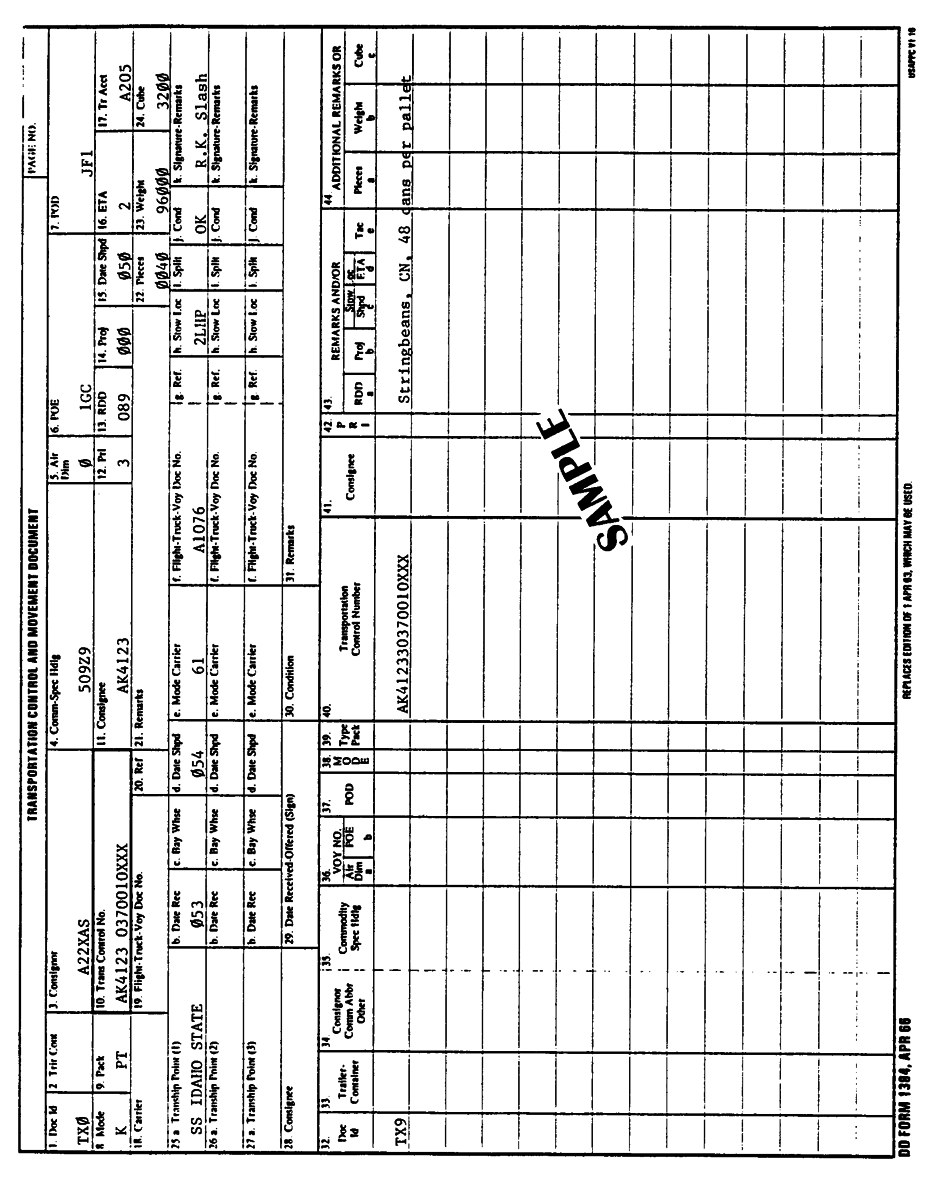
FM 55-80
F-7

FM 55-80
F-8

FM 55-80
F-9
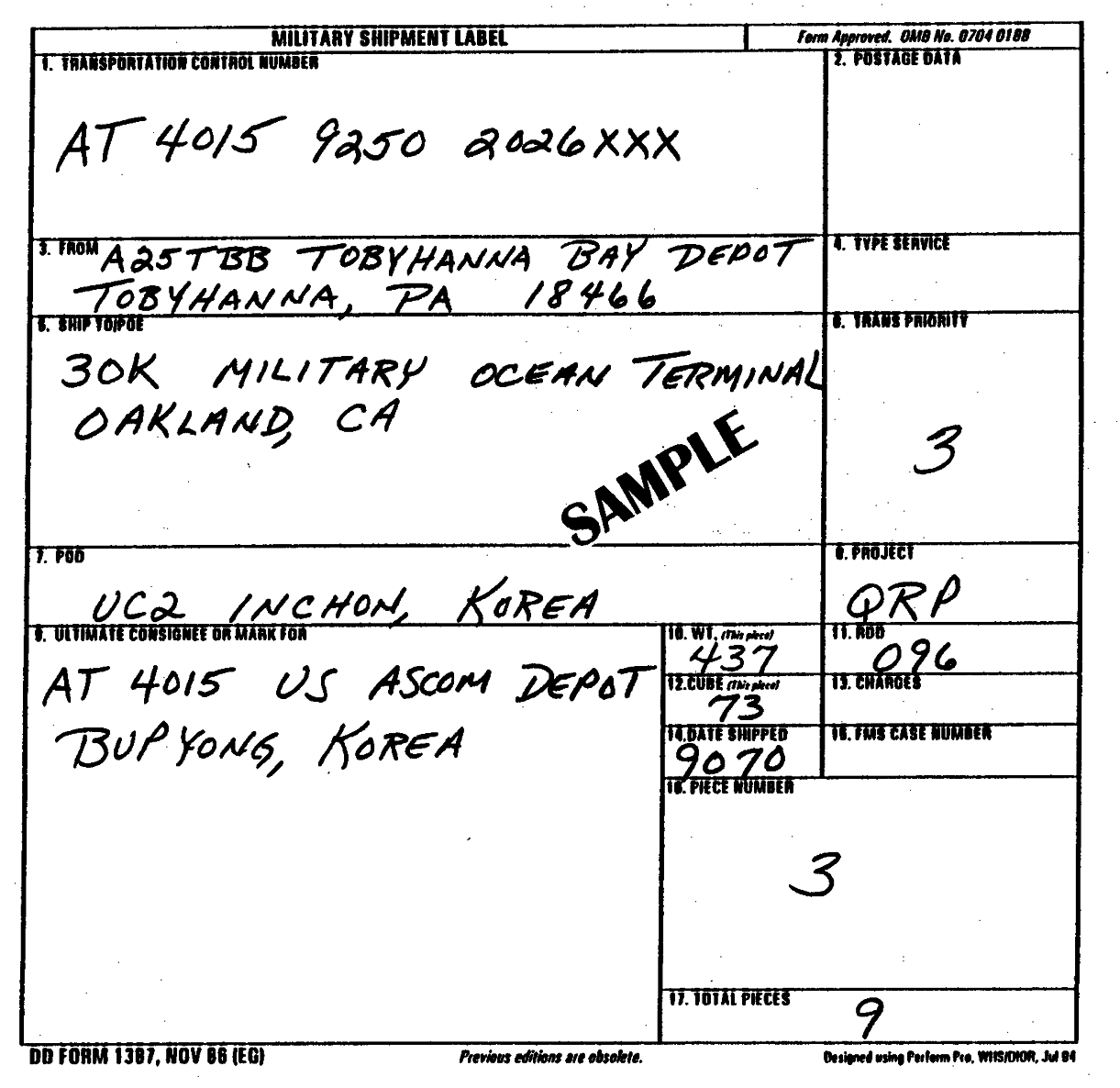
FM 55-80
F-10
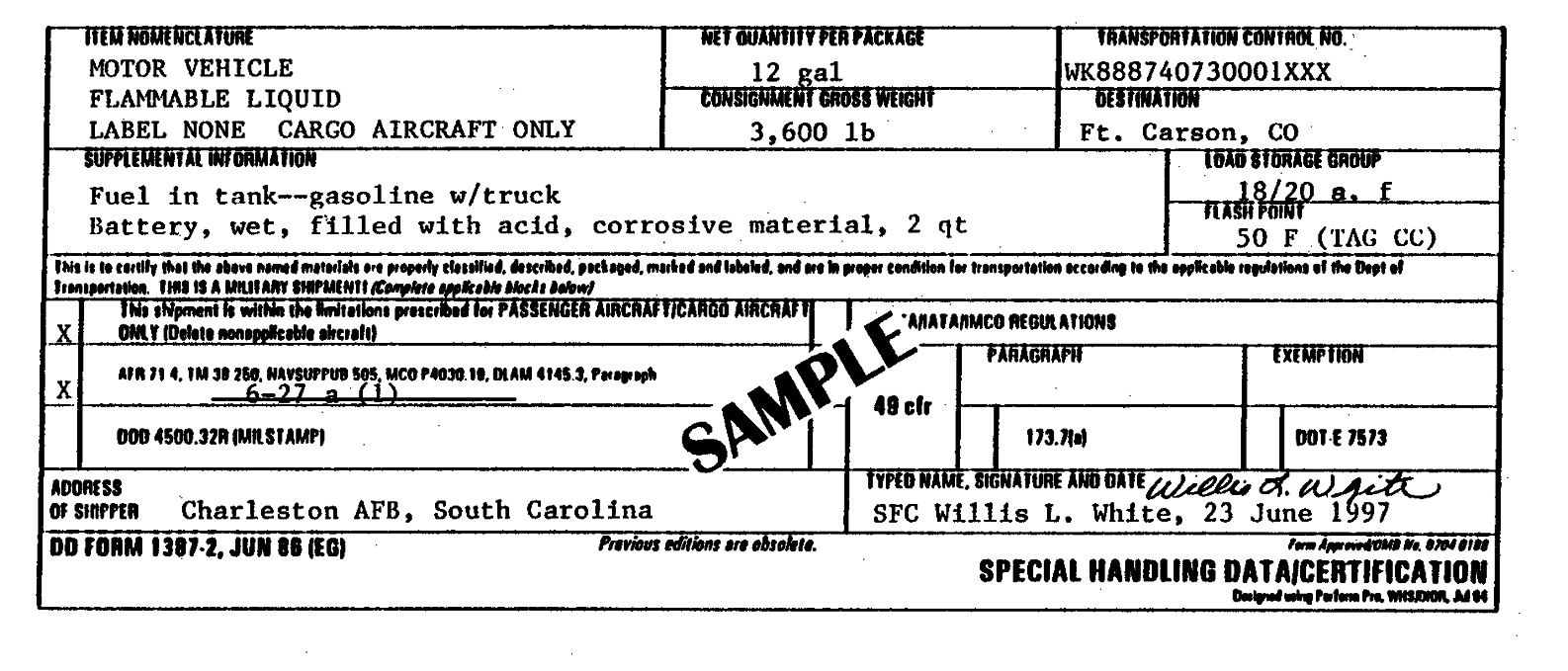
FM 55-80
F-11
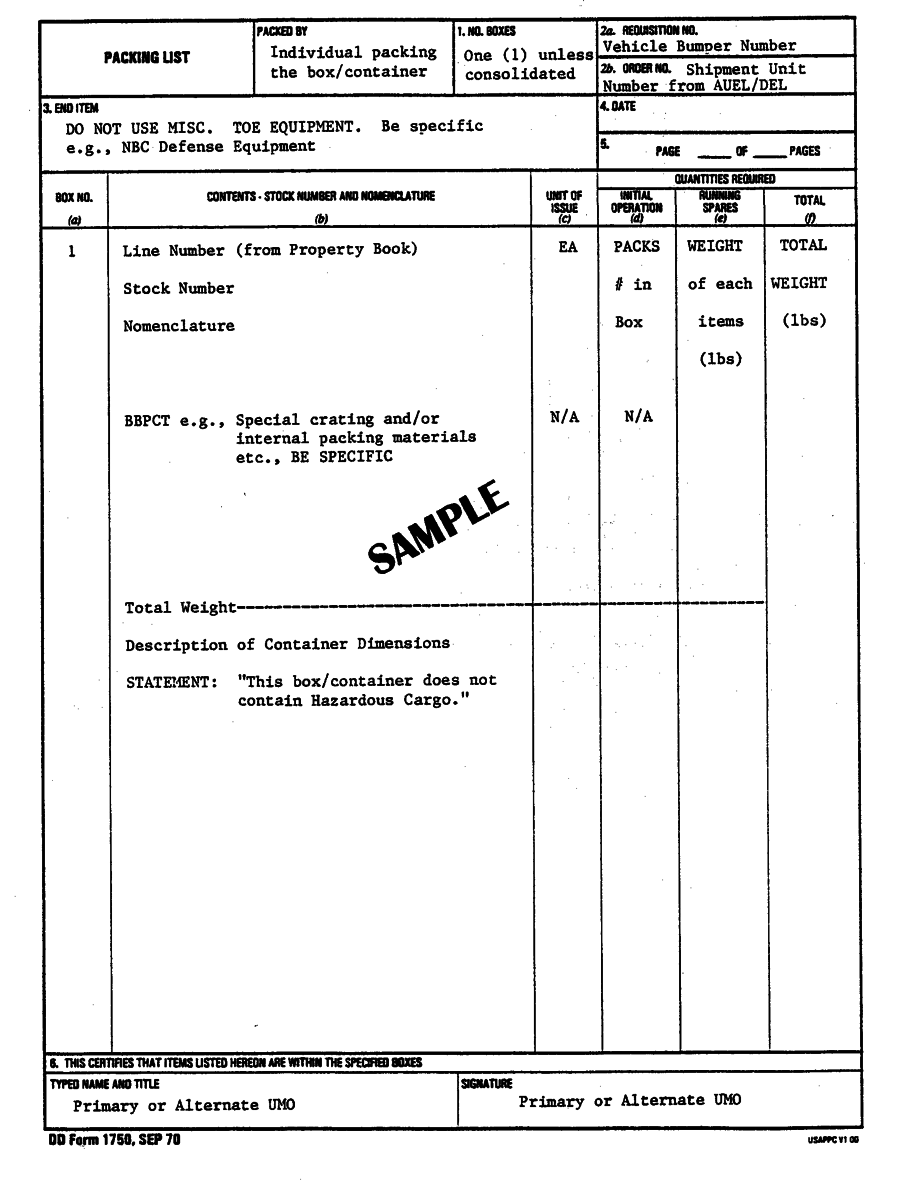
FM 55-80
F-12
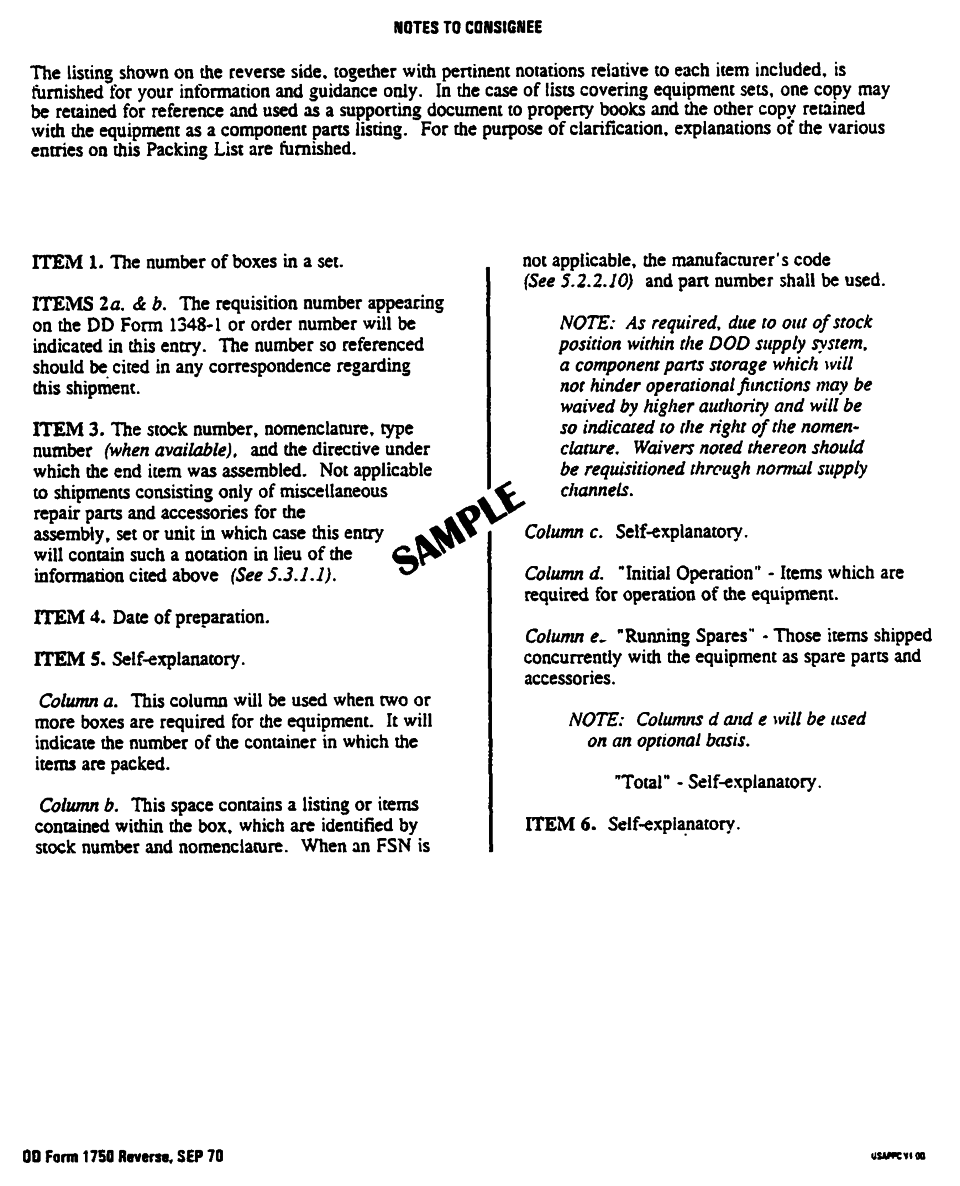
FM 55-80
F-13
FM 55-80
GLOSSARY
AA assembly area
AAFES Army Air Force Exchange Service
ACEP Approved Continuous Examination Program
A/DACG arrival/departure airfield control group
ADUSD-TP Assistant Deputy Under Secretary of Defense, Transportation Policy AFPDA Army Force Planning Data and Assumptions
AIS automated information systems
AIT automatic identification technology
allowable stacking weight The amount of weight that can be stacked on corner posts of a container when subjected to 1.8 times the force of gravity.
ALO authorized level of organization
ALOC air line of communication
ALM Air Load Module
AMC Air Mobility Command; Army Materiel Command
American National Standards Institute The United States standards organization that establishes procedures for the development and coordination of voluntary American National Standards.
AMMO ammunition
AMS Automated Manifest System
ANSI American National Standards Institute
AOR area of responsibility
APO Army Post Office
APOD aerial port of debarkation
APOE aerial port of embarkation
approval authority A representative (person or organization) of the Commandant, US Coast Guard, authorized to approve containers within terms of the International Conference for Safe Containers.
AR Army regulation
ASCC Army service component command
ASG area support group
ASP ammunition supply point
ATCOM Aviation and Troop Command
ATLAS all terrain lifter articulated system
ATP ammunition transfer point
ATTN attention
AUEL automated unit equipment list
automatic identification technology AIT is a family of data capturing devices designed to provide rapid and accurate acquisition, retention and retrieval of source data. The technology includes a spectrum of capabilities (for example, bar codes, microcircuit devices, optical reading, and so forth).
Automatic Manifest System LASER CARDS (also called Optical Laser Cards) These credit card-sized mediums can store approximately 1,200 pages of information in a "write once, read many" (WORM) format similar to a compact disk. A laser card reader/writer is required to use the card. These were considered for transportation applications, but subsequently eliminated because handling the cards impedes the movement process.
AWR Army war reserves
AWR-3 Army War Reserve 3
battlefield distribution BD is a holistic methodology (strategic through tactical) of information exchanges, management procedures, functional designs, and reengineered operational process which Glossary-1
FM 55-80
enable US Forces to properly request, receive, redirect, track, distribute, control, and retrograde materiel, facilities and services within a single distribution system.
B.B.P. breakbulk point
BBT blocking, bracing and tie-down
BD Battlefield Distribution
BDE brigade
Bldg building
BN battalion
breakbulk cargo Any commodity that, because of its weight, dimensions, or noncompatibility with other cargo, must be shipped by mode other than MILVAN or SEAVAN.
breakbulk ship A ship with conventional holds for stowage of breakbulk cargo, below or above deck, and equipped with car































